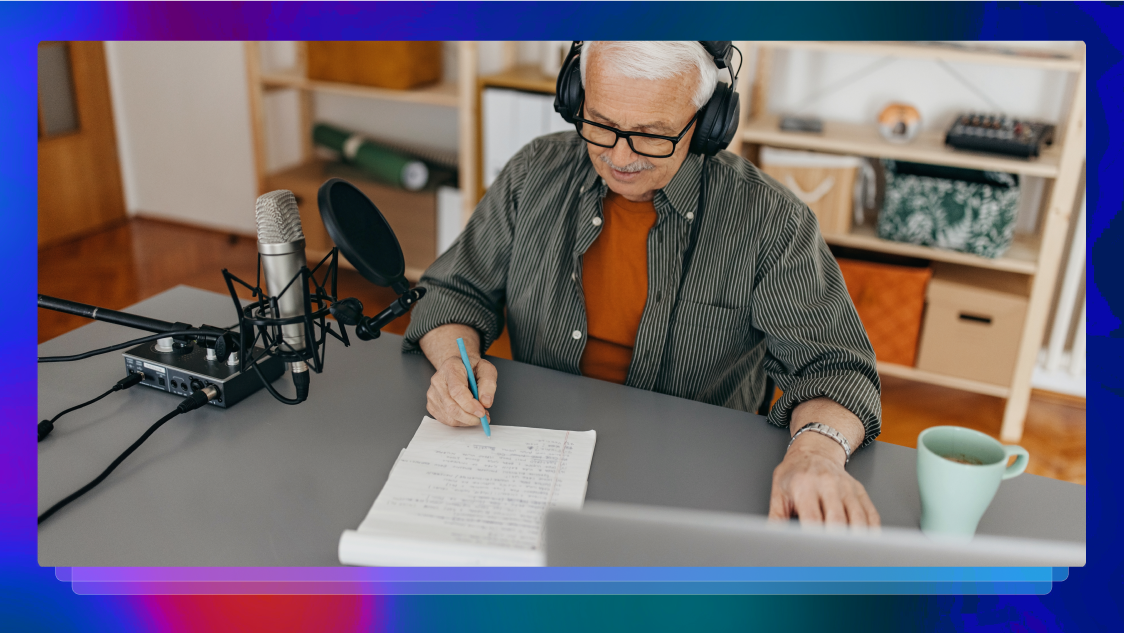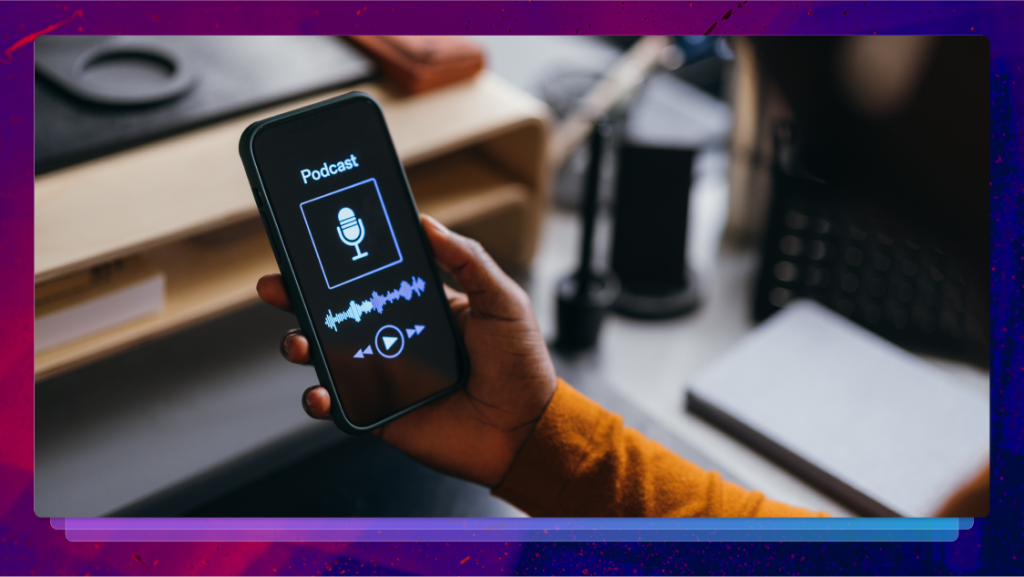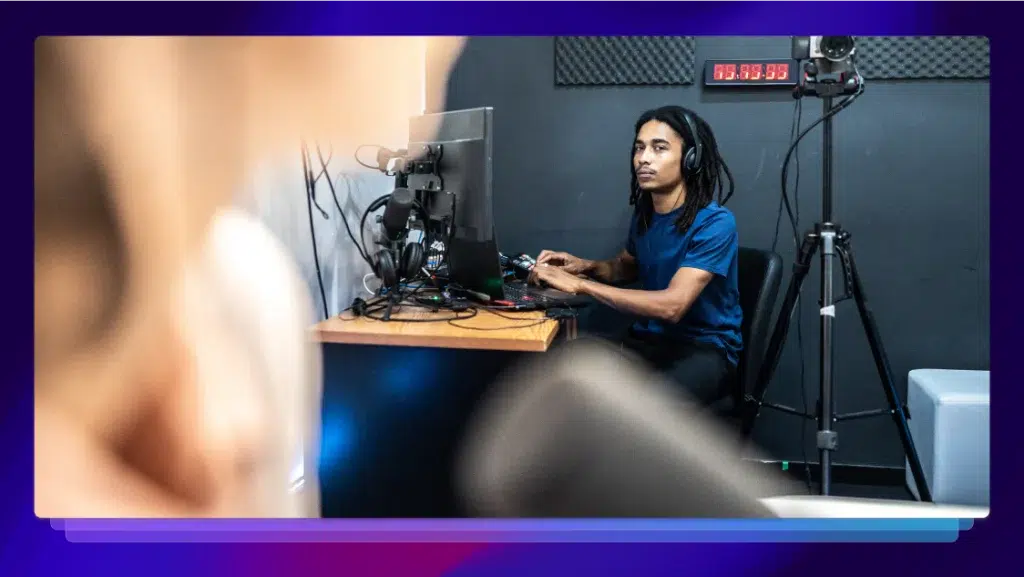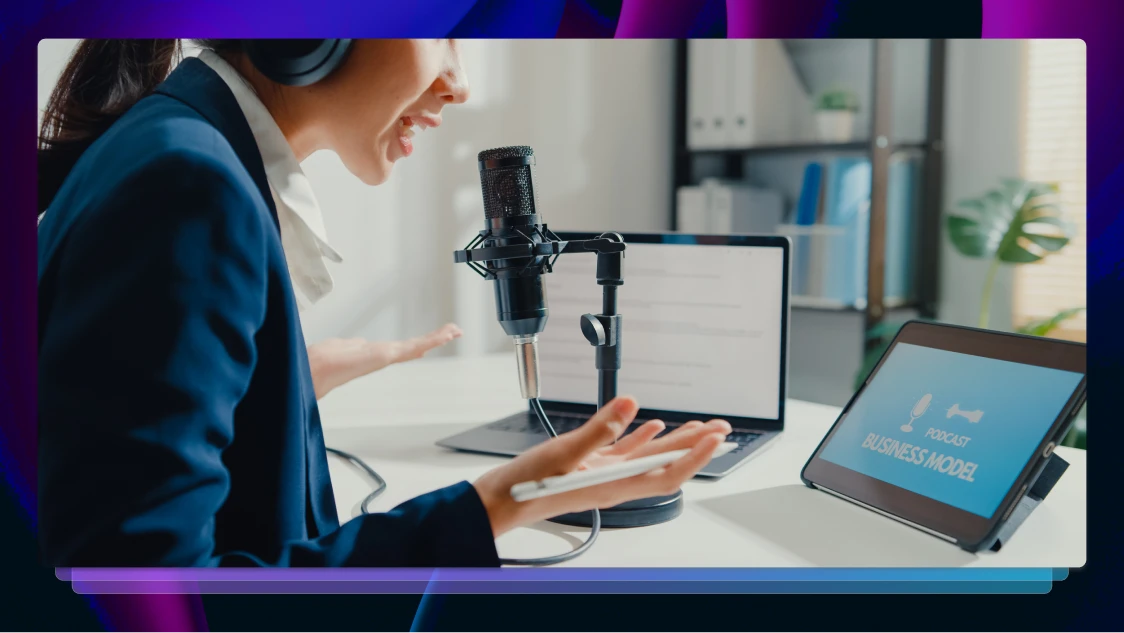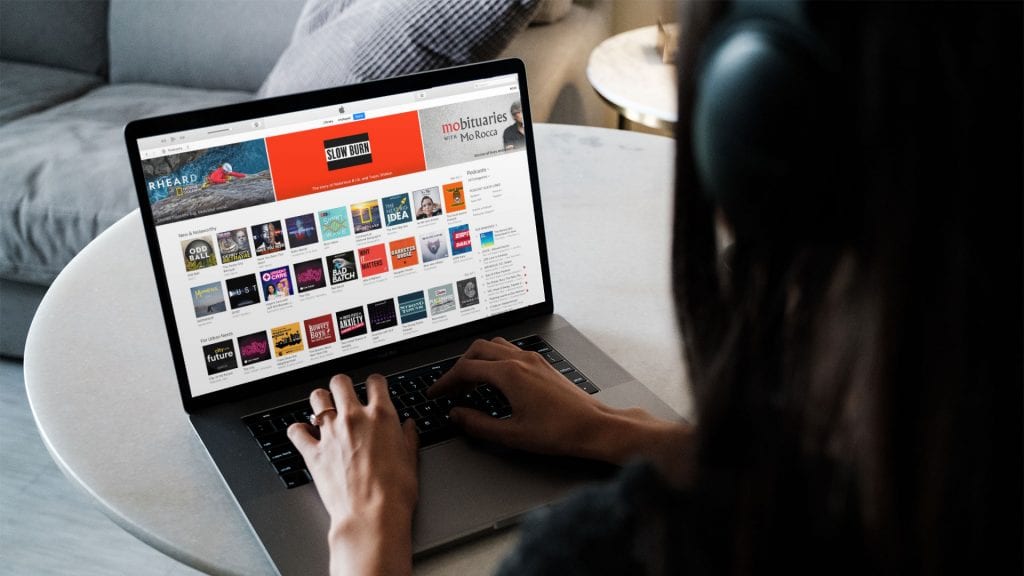How to Start a Podcast With No Audience: It Can Be Done!
If you’re wondering how to start a podcast audience with no audience, rest assured: It can be done! And Rev will tell you how in 12 steps.
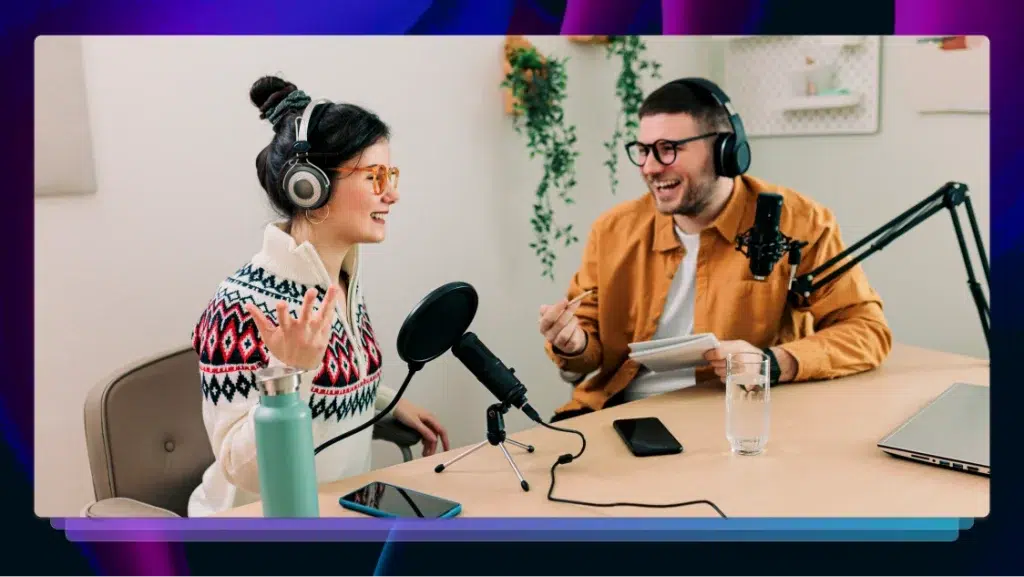
With more than 4 million podcasts in production today, you might be thinking “It can’t be that hard to start my own podcast,” and you’d be right! It’s not incredibly difficult to start a podcast. Anyone can grab a few decent microphones and start talking, right?
But who will listen? That’s where the difficulty lies. Unless you’re already famous, there’s a good chance that your podcast’s initial audience will be close to zero. So how do you start a podcast with no audience?
Building a podcast audience from scratch sounds intimidating, but rest assured that it can be done (we know from experience — check out how we’re growing our new podcast, The Rough Draft). The vast majority of podcasts started just like yours. Here are a few things to consider when wondering how to start a podcast with no audience.
1. Develop a Theme You’re Passionate About
Half the battle when building a podcast following is simply being interesting, and you can accomplish that by talking about the things you’re interested in. If you’re genuinely interested in your subject, your audience will pick up on that and join you for the ride.
Not every theme is for every person, so if you choose a super-niche topic, like, say, “Car-chase movies made in 1957,” there’s a good chance that you won’t become the next “Serial.” But the people who are into that topic? They’ll really enjoy it. That said, a topic or theme with mass appeal that you don’t care about might send audiences scurrying away. So temper your audience expectations with your chosen topic.
If you’re passionate and knowledgeable about your overall subject, you’ll engage your listeners, and engaged listeners will spread the word. Chances are your initial marketing budget will be small, too, if it exists at all. Thankfully, word-of-mouth advertising is essentially free, so engaging your audience and having them do the work can make or break your early days.
2. Name Your Podcast
Naming your podcast is arguably the hardest part of the whole process. Your podcast’s name should directly reflect your chosen theme or subject. It’s a chance to be clever, but not too clever. It needs to say a lot without being confusing. A potential listener should be able to know exactly what your podcast is about but also be intrigued enough to tune in.
Your podcast’s name should:
- Be clear and effective
- Complement the tone of your theme
- Be creative and thoughtful
- Engage your audience and draw them in
Hey, we said naming your podcast wouldn’t be easy!
3. Define Your Ideal Podcast Audience
Since you don’t yet have an audience, this is the perfect time to define your ideal audience. Once you’ve defined them, you can better target them with content and, eventually, marketing. It’ll take a little research, but it’ll also take some “gut feelings” based on what you know of your podcast theme.
Start by asking these questions:
- How old are your ideal listeners?
- What are their interests and habits?
- Where do they live and work?
- What do they watch on TV?
- What do they read?
- What big purchases do they make?
- What regular purchases do they make?
- What do they do for fun?
- Where do they hang out offline and online?
- Did they go to college?
- Do they have pets?
- Do they have kids?
- What causes do they care about?
The answers to these questions will guide you more than you can possibly imagine and even define your content moving forward.
4. Upload a Transcript of Each Episode
In today’s online universe, SEO is what makes the world go around. SEO, however, doesn’t play well with audio-only formats, so it’s important to create a text version of your podcast to generate online traffic for your podcast’s website. The easiest way to do this is to create transcripts of every podcast episode.
Transcripts create naturally keyword-rich content that Google (and other search engines) crawlers will recognize and use to send organic search results in your direction. For organic search results, written content is king, and a transcript of the average 40- to 60-minute podcast is a lot of content.
Getting transcripts created is easy, thanks to a few reputable podcast transcription services we may know!
5. Ignore the Critics
Not every podcast is for everyone, but that won’t stop people from chirping about everything they don’t like about yours. You shouldn’t get discouraged about people — amateur and professional alike — who are critical of your podcast. It’s going to happen. As long as you’re aiming to please your target audience, the naysayers don’t matter much.
That’s not to say you can’t use criticism to better your podcast. There’s nothing more valuable than constructive criticism, especially for beginners. You can use comments about things you can directly address — audio quality, episode length, episode frequency, difficulty with finding you — to improve in the future.
6. Book Guests For Your Podcast
As engaging as you are or as hypnotic as your voice might be, you’ll more than likely need a guest sooner or later. A full-on conversation is usually a lot more interesting than one person talking (unless you’re a Dan Carlin).
But how do you find guests for a podcast with no audience? Here are a few places to start looking for guests:
- Your personal network. Chances are, if you’re passionate about your topic, you already know a few people who share that passion. Invite them to chat!
- Social media. You’re probably already using a valuable resource for finding guests. Twitter, LinkedIn, and Instagram are incredibly searchable via hashtags. Just search for #Yourtopic and you’re bound to find in-progress conversations. From there, you can find the most interesting voices and reach out.
- BuzzSumo. It’s a tool to analyze what content performs best for any topic or competitor. You can search in Buzzsumo by a keyword or phrase, or browse the trending topics section. Once you’ve narrowed your search to the appropriate areas of focus, you can reach out to influencers within the space.
- HARO. Formerly Help a Reporter Out, HARO is a tool journalists use to find sources for their stories. It’s a pretty nifty tool for podcasters, too. Simply sign up, post what you’re looking for, and people will email you. While not foolproof, you’re likely to find at least one person that fits the bill, and the tool can lead to a steady stream of engaging personalities.
Of course, booking guests is only half the battle. You also need to interview them! What kind of questions should you ask your guests to entice interesting answers? Glad you asked! (Great question, by the way. You’re learning quickly!)
Here are five questions sure to get your guest talking:
- “What’s your go-to order at your favorite hometown restaurant?”
- This question will put your guest at ease and get some insight into their background.
- “What do you wish you had known when you started out?”
- Asking this will showcase the value of learning on the job.
- “What are you curious about right now?”
- If you let your guest speak about their passions, they’ll do most of the work themselves!
- “What’s something you’ve failed at?”
- This question lets your guest demonstrate how your audience can overcome challenges.
- “Is there anything I should have asked, but didn’t?”
- There’s almost always something your guest wants to talk about that you could never have known. It’s usually a pretty interesting subject!
7. Set Up Your Studio
Podcast recording studio setups vary widely. From kitchen tables to million-dollar studios, every one of them is wildly different and suited to the creators’ abilities, budgets, and needs. Even if you’re a brand new ‘caster podcasting on a budget, there are some essentials that you’ll need to start with:
- Computer. You’ll need a computer to record, edit, and upload your podcast. At first, you won’t need anything very expensive or advanced, but if you decide to dive headfirst into more complicated production, you’ll need a computer with powerful processing ability.
- Microphones (XLR or USB). It’s technically possible to record your podcast using your laptop’s microphone (and/or video camera if you go the visual route), but since podcast listening is largely an audio format, audio quality matters. Even a $50 microphone is a huge step up from your laptop’s mic, and some cheaper microphones are perfectly viable for your podcast. Most beginners use USB microphones, which plug into your computer’s USB port. More advanced podcasters will use XLR mics, which connect to a mixer as well as your computer.
- Pop filters. This is the foam or mesh screen that wraps the microphone. Pop filters can cost less than $10 but their function is invaluable: They lessen the impact of certain letter sounds as we say them, Ps and Ts, specifically. Without the filter, listeners can get blown out by the PUH in podcast!
- Podcasting headphones. Just like with microphones, when you’re first starting a podcast, you can use even the most basic headphones. We recommend over-the-ear headphones for everyone recording so you have an accurate representation of what your audio sounds like. As you become a more advanced podcaster, you’ll likely want to look into more advanced (re: expensive) headphones.
- Editing software. Your digital audio workspace (DAW) is the last thing you’ll need before hitting record. When starting your podcast, free DAW software like Garageband for Mac and Audacity for PC are great basic options that let you shape your audio exactly how you need it without requiring an advanced degree in sound engineering.
8. Find the Right Place to Host
When starting a smaller podcast, you’ll want to look for a hosting company that provides a reliable platform where you can upload and store your audio or video files and publish your podcast. They’ll also provide you with your RSS feed and some basic analytics. Many hosting platforms fit the bill here, but these are the most pervasive:
10. Run Lean
You can almost create a podcast for free, once you have some basic equipment. That’s the beauty of the medium. If you keep your expenses to a minimum, your chances for at least some success increase because, at the very least, you won’t be in a financial hole from the outset.
Here are some tips for starting a podcast and keeping costs low:
- Don’t spring for fancy equipment
- Skip paying to have guests on — at least at the beginning
- Record from home, not in a rented studio
- Edit your podcast yourself
- Stick to social and word-of-mouth marketing
11. Find Sponsors
This is the hardest step for a fledgling podcast, but also the one with the most direct link to profitability. Sponsorships mean revenue. But that means your content needs to be worthwhile to a sponsor. So how do you acquire those sponsors?
Some hosting companies offer dynamic ad insertion tools so that you can easily insert ads into your show. There’s usually a fee involved and you’ll only make money if your podcast performs well. It’s a bit risky if you’re already on a shoestring budget.
You can also approach sponsors yourself to avoid any upfront fees. The crux here is that your podcast needs to perform well for most sponsors to find it worthwhile. But if you’re confident in your content and can sell the potential sponsor on your ideas, it can be quite lucrative.
A traditional measurement of online advertising rates is CPM (cost per mille) which translates from Latin as “Cost Per Thousand.” This means a sponsor will pay X dollar amount per 1,000 downloads of your podcast. For a new, struggling podcast, that amount might be very small, though.
12. Don’t Get Discouraged
When starting a podcast, it’s easy to get discouraged by many things. Low audience numbers, harsh comments, no income. The important thing is to keep going and remember that you might publish 20 episodes or more before you develop any sort of following. The worst possible thing you can do is slow down your output, though. Podcast fans love consistency, and if you’re struggling for an audience, not sticking to that audience’s expectations is a signal that they should look elsewhere.
Stick with it, do your best and results will come!
Benefits of Podcasting For Your Brand
If you’re starting a podcast to enhance your brand, you’re on the right track. When you create a podcast for free, you essentially create free long-form advertising for your brand. With the right strategy and some hard work, you could see some incredible low-cost benefits, like:
- A rep for thought leadership: By focusing on education and information that your listeners want, you’ll eventually be recognized as a thought leader in your chosen topic. Your listeners will want to hear what you have to say which means they trust you and your brand.
- Improved SEO: With transcriptions of every episode, you’ll generate plenty of SEO-rich content, which leads to great organic search traffic.
- Wider reach: If your podcast features guests, those guests will naturally promote their appearance. That means that their network, at least temporarily, becomes your network. That new listener base can convert into customers and advocates for your brand.
Podcasting FAQs
When you’re trying to figure out how to set up a podcast, you’ll have questions. Luckily for you, many others have had the same frequently asked questions! Here’s a list of FAQs about early podcast dos and don’ts.
What Is the Bare Minimum Needed To Start a Podcast?
The bare minimum you need to start a podcast is a microphone, a computer, and a good idea. That’s it! With those three things, you can record an episode of your podcast, give it a basic edit, and post it to a hosting site.
That’s not to say that using only the bare minimum is the best idea in the world. With some minor additions like audio editing software, a second microphone, a guest, and a visual identity, you can really get your podcast rolling.
Are Small Podcasts Profitable?
Yes, small podcasts can be profitable. That doesn’t mean that they will be profitable, though. While some small podcasts catch fire and become financially successful immediately, many more never make a dollar.
Podcasts make money in a few primary ways:
- Sponsorships: A single brand pays for the whole series or specific episodes
- Subscriptions: Listeners pay directly to listen, through services like Patreon
- Ad revenue: Paid brand spots before, during, or after each episode
- Premium content: Listeners get some content for free, but are offered the opportunity to pay for more
- Product sales: T-shirts, can koozies, live event tickets, etc
Most potential revenue streams work best after you’ve developed a following, so don’t jump into your podcast needing an instant paycheck. If your podcast supports an existing brand, product sales related to that brand can jumpstart your revenue. The rest require time to build a following.
However, “profitable” is a relative term, right? If you don’t spend any money, even a single dollar puts you in the black. If you keep your operation lean, a small podcast could start making a profit sooner than you’d expect.
What Is the Easiest Platform To Start a Podcast?
In our opinion, the easiest platform to start a podcast on is Apple Podcasts, although there’s no one-size-fits-all answer. We recommend Apple because of its reach; by hosting your podcast on Apple, your podcast will automatically show up in other podcast players without a lot of legwork on your end.
Podcasting Terms To Familiarize Yourself With
A huge part of knowing how to start a podcast for beginners is knowing a healthy portion of the terminology used in the podcasting industry. It can be intimidating, but you don’t need to know everything all at once. Here’s a good start on terms you should be familiar with:
- Audio file: The format of your recording. The most common types are .mp3 or .wav files.
- Bit rates: Measured in kilobits per second (kbps), the bit rate lets you know how many kilobits make up each second of audio on your podcast. The higher the bit rate, the higher the file size.
- Clipping: In your waveform, there will be spikes where people are louder during the broadcast. If these spikes touch the bottom (floor) or top (ceiling) of your recording, your audio has clipped. Excessive clipping detracts from your audio recording. Solutions include lowering the gain or input level on your microphone, or asking guests to speak more quietly.
- Condenser microphone: A microphone that requires its own power through a battery, outlet, or a mixer. Condenser microphones are typically more sensitive than dynamic mics.
- Dynamic microphone: A microphone that doesn’t require its own power source. Dynamic microphones are typically less sensitive than condenser mics.
- Digital Audio Workstation (DAW): Where you record your podcast. Examples include GarageBand, Audacity, and LogicPro.
- Hosting service: Where your podcast lives. A podcast host simplifies and automates the RSS feed, file hosting, and delivery of episodes to your subscribers. Sites like PodBean, Blubrry, Libsyn, and SoundCloud offer hosting capabilities.
- Levels: Measured in decibels (db), this is how loud your podcast (or each speaker) is. Anything above 0 db will result in clipping; an ideal audio ceiling is about -3db to -6db.
- Metadata: Information embedded in your episodes. Metadata can consist of the episode and podcast name, artwork, the year of recording, and any featured music.
- Mixer: A device that allows you to mix different elements into your show during your recording, as opposed to doing so in post-production. Use a mixer to add things like music, sound effects, and audio clips. You can also individually adjust the volume levels of each host or guest.
- Podcast directory: Places where your audience can listen to your show. Examples include Apple Podcasts, Google Podcasts, Spotify, Stitcher, and TuneIn.
- Post-production: The act of editing, tweaking, or otherwise enhancing your podcast after recording. This includes adding ads or music.
- Pre-roll: An announcement or advertisement that plays before the start of your episode.
- RSS feed: A unique link given to you by your media host when you create your podcast series. Use your RSS feed to submit your show to podcast directories.
- USB microphone: A microphone that plugs into your computer or mixing device via USB.
- Waveform: The box or window that contains your recording. This is shaped in correspondence to the volume of the person speaking. Keep an eye out for spikes that result in clipping.
- XLR: This most often references the cable that connects your microphone to a mixer, amp, or recorder. The most common variation is a male-to-female cable or cord.
Let Rev Become Your First Listener
When figuring out how to start a podcast with no audience, it can be intimidating, but rest assured it’s far from impossible. With a little know-how and some dedication, your following will grow from exclusively friend-and-family listeners to dozens to hundreds and beyond (maybe it will even be included in our list of best productivity podcasts one day).
Kickstart your growth by letting Rev in on the ground floor — our podcast transcription services will help you get where you need to go.

.webp)

